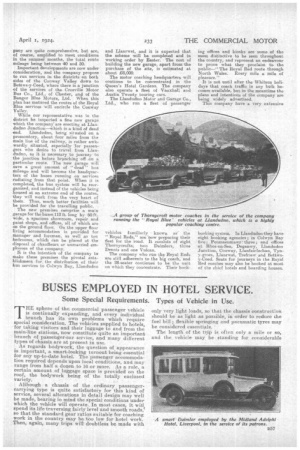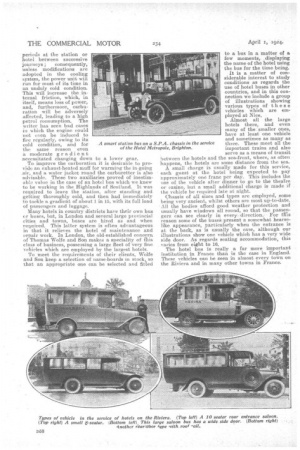BUSES EMPLOYED IN HOTEL SERVICE.
Page 51

Page 52

If you've noticed an error in this article please click here to report it so we can fix it.
Some Special Requirements. Types of Vehicle in Use.
THE sphere of the. commercial passenger vehicle is continually expanding, and every individual branch has its own problems which require special consideration. The vehicles supplied to hotels, for taking visitors and their luggage to and from the main-line stations, now constitute quite an important branch of passenger-car service, and many different types of chassis are at present in use.. As regards bodywork, the question of appeal-8.nm is important, a smart-looking turnout being essential for any up-to-date hotel. The passenger accommodation required depends upon local conditions, and may range from half a dozen to 16 or more. As a ride, a certain amount of luggage space is provided on the roof, the bodywork being of the totally enclosed
variety..
Although a chassis of the ordinary passengercarrying type is quite satisfactory for this kind of service, several alterations in detail design may well be made, bearing in mind the special conditions under which the vehicle will operate.,In most cases, it wiil spend its life traversing fairly level and smooth roads,1 so that the standard gear ratios suitable for coaching work in the country may be too low for hotel work. Then, again, many trips will doubtless be made with only very light loads, so that the chassis construction should be as light as possible, in order to reduce the fuel bill ; flexible springing and pneumatic tyres may be considered essentials.
The length of the trip is often only a. mile or so, and the, vehicle may be standing for considerable periods at the station or hotel between successive journeys ; consequently, unless modifications are adopted in the cooling system, the power unit will run for most of its time in an unduly cold condition. This will increase the internal friction, which, in itself, means loss of power, and, furthermore, carburation will be adversely affected, leading to a high petrol consumption. The writer has seen bad cases in which the engine could not even be induced to fire its cold regularly, owing to cold condition, and for the same reason even. a moderate gradient necessitated changing down to a lower gear. To improve the carburation it is desirable to provide an exhaust-heated muff for warming the in-going air, and a water jacket round the carburetter is also advisable. These two auxiliaries proved of inestimable value in the case of an hotel bus which we knew to be working in the Highlands of Scotland. It was required to leave the station, after standing and getting thoroughly cold, and then had immediately to tackle a gradient of about 1 in 15, with its full load of passengers and luggage.
Many hotels in country districts have their own bus er buses, hut, in London and several large provincial cities and towns, buses are hired as and when required. This latter system is often advantageous in that it relieves the hotel of maintenance and repair work. In London, the old-established concern of Thomas Wolfe and Son makes a speciality of this class of business, possessing a large fleet of very fine vehicles which are employed by the largest hotels.
To meet the requireinents of their clients, Wolfe and Son keep a selection of name-boards in stock, so that an appropriate one can be selected and fitted to a bus in a matter of a few moments, displaying the name of the hotel using the bus for the time being.
It is a matter of considerable interest to study conditions as regards the use of hotel buses in other countries, and in this connection we include a group of illustrations showing various types of t hese vehicles which are employed at Nice. Almost all the large hotels there, and even many of the smaller ones, have at least one vehicle and sometimes as many as three. These meet all the important trains and also serve as a means of transit between the hotels and the sea-front, where, as often happens, the hotels are some distance from the sea. A small charge is usually made for this service, each guest at the hotel being expected to pay 'approximately one franc per day. This includes the use of the vehicle after dinner to go to the theatre or casino, but a small additional charge is made if the vehicle be required late at night. Chassis of all sizes and types are employed, some being very ancient, whilst others are most up-to-date. • All the bodies afford good weather protection and usually have windows all round, so that the passengers can see clearly in every. direction,For tRis reason some of the buseg present a somewhat hearselike appearance, particularly when the entrance is at the back, as is usually the case, although our illustrations show one vehicle which has a very wide side door. As regards seating accommodation, this varies from eight to 16. The hotel bus is really a far more important institution in France than is the case in England. These vehicles can be seen in almost every town on the Riviera and in many other towns in France.






















































